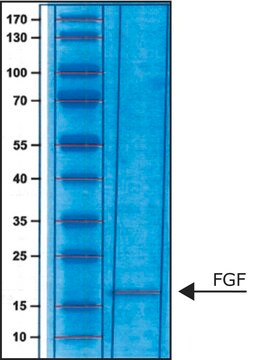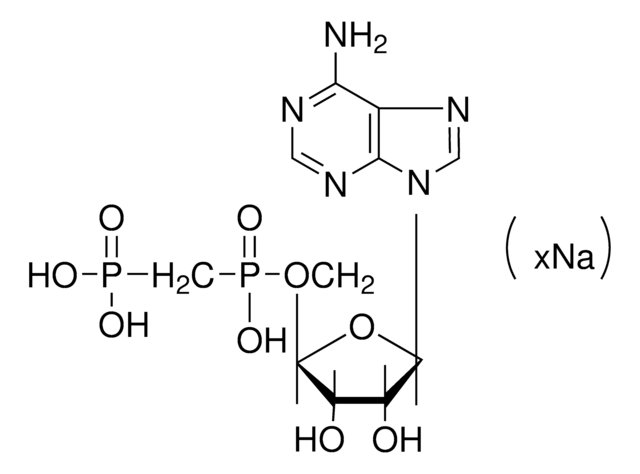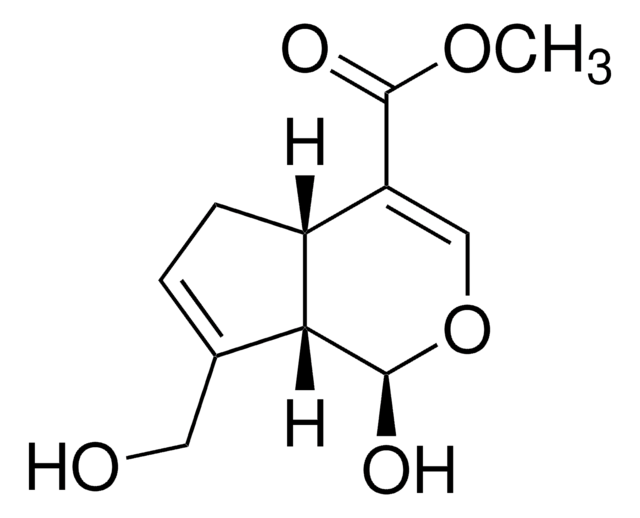F7301
Fibroblast Growth Factor-18 human
>95% (SDS-PAGE and HPLC), recombinant, expressed in E. coli, lyophilized powder
Synonym(s):
FGF-18
Sign Into View Organizational & Contract Pricing
All Photos(1)
About This Item
Recommended Products
biological source
human
Quality Level
recombinant
expressed in E. coli
Assay
>95% (SDS-PAGE and HPLC)
form
lyophilized powder
potency
≤0.5 ng/mL
mol wt
predicted mol wt 21.2 kDa
packaging
pkg of 25 μg
storage condition
avoid repeated freeze/thaw cycles
impurities
endotoxin, tested
UniProt accession no.
storage temp.
−20°C
Gene Information
human ... FGF18(8817)
General description
FGF18 (fibroblast growth factor 18) is a member of the FGF family, and is a part of the FGF8 subfamily, which also includes FGF8 and FGF17. It is a paracrine-acting protein, and does not undergo alternative splicing. It is produced as a precursor of 207 amino acids, from which the signal peptide of 27 hydrophobic amino acids is cleaved of. This gene is localized to human chromosome 5q35.1, which produces a protein of 21.2kDa.
Biochem/physiol Actions
FGF-18 is a heparin binding growth factor, which stimulates the proliferation and activation of cells that express the FGF receptors.
FGF18 (fibroblast growth factor 18) functions in both developing and adult organisms, and plays a predominant role in skeletal development. It is a putative early marker for prostate and ovarian cancer, and has potential as a target in the same. It mediates gene profiling, and has anticatabolic effects mediated through Timp1 (tissue inhibitor of metalloproteinases). Thus, it has confers protection on adult articular cartilage. In mice embryos, inactivation of this gene results in death due to aberrations in alveologenesis and skeleton development.
Stimulates the proliferation and activation of cells that express the FGF receptors.
Physical form
Lyophilized from a 0.2 μm filtered solution in 10 mM Tris, pH 8.0 + 20mM NaCl.
Analysis Note
The biological activity is determined by the dose-dependent stimulation of thymidine uptake by BaF3 cells expressing FGF receptors.
Signal Word
Warning
Hazard Statements
Precautionary Statements
Hazard Classifications
Eye Irrit. 2 - Skin Irrit. 2 - STOT SE 3
Target Organs
Respiratory system
Storage Class Code
11 - Combustible Solids
WGK
WGK 2
Flash Point(F)
Not applicable
Flash Point(C)
Not applicable
Choose from one of the most recent versions:
Already Own This Product?
Find documentation for the products that you have recently purchased in the Document Library.
The crystal structure of fibroblast growth factor 18 (FGF18).
Alan Brown et al.
Protein & cell, 5(5), 343-347 (2014-03-29)
Wei Wei et al.
The Journal of clinical investigation, 123(10), 4435-4448 (2013-09-11)
High-throughput genomic technologies have identified biomarkers and potential therapeutic targets for ovarian cancer. Comprehensive functional validation studies of the biological and clinical implications of these biomarkers are needed to advance them toward clinical use. Amplification of chromosomal region 5q31-5q35.3 has
Yoshifumi Mori et al.
The Journal of biological chemistry, 289(14), 10192-10200 (2014-03-01)
To identify genes that maintain the homeostasis of adult articular cartilage and regenerate its lesions, we initially compared four types of chondrocytes: articular (AA) versus growth plate (AG) cartilage chondrocytes in adult rats, and superficial layer (IS) versus deep layer
Amy P Wong et al.
Nature protocols, 10(3), 363-381 (2015-02-06)
Airway epithelial cells are of great interest for research on lung development, regeneration and disease modeling. This protocol describes how to generate cystic fibrosis (CF) transmembrane conductance regulator protein (CFTR)-expressing airway epithelial cells from human pluripotent stem cells (PSCs). The
Articles
Fibroblast growth factors in cell culture and various growth factors for your research
Our team of scientists has experience in all areas of research including Life Science, Material Science, Chemical Synthesis, Chromatography, Analytical and many others.
Contact Technical Service









